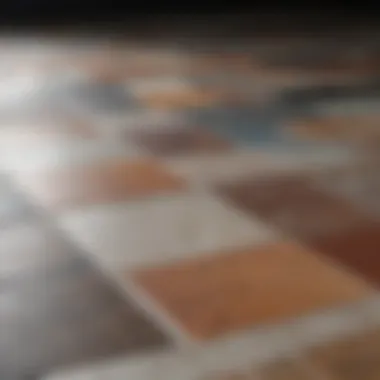Peeling Back Floor Tiles: A Comprehensive Guide


Intro
Peeling back floor tiles is a task many homeowners encounter at some point. This process can seem daunting, but it also presents an opportunity for innovation and renewal in home design. Whether it's for a renovation, repair, or style update, understanding the process is essential. The floors set the tone for any space, and their condition can greatly affect aesthetic appeal and value. From identifying the type of tiles to knowing the right tools, being well-educated can transform the experience from a tedious undertaking to a rewarding project.
Removing floor tiles requires consideration of various factors. Different tiles have different properties, and knowing whether your tiles are ceramic, vinyl, or other materials will guide you in choosing the appropriate techniques for removal. Each type may require unique tools and methods. Additionally, considering why you wish to remove the tiles is also crucial. Whether for aesthetic changes, damage repair, or new professionals flooring, having a clear goal will direct the whole process.
Before delving into the specifics of removal, it is essential to explore the broader context of design choices that influence the overall outcome. This helps in making the right decisions not just for the tiles you are removing but also for the style of replacement.
Design Inspirations
When renovating or updating floors, inspiration is everywhere. From Pinterest boards to home improvement magazines, design ideas flow freely in today’s home decor culture. Understanding current trends allows homeowners to make informed choices on materials and patterns.
Trending Styles
Contemporary trends show a shift towards natural materials such as wood and stone. However, durability matters too, especially in high-traffic areas. Vinyl tiles have gained popularity due to their resilience and variety in designs. There are faux-wood and patterned options that imitate natural looks without the associated maintenance challenges.
- Natural Stone: Offers elegance and durability.
- Ceramic Tiles: Versatile and easy to maintain.
- Vinyl: Cost-effective and available in numerous designs.
Exploring these styles can provide practical layouts that enhance functionality while remaining visually appealing.
Color Palettes
Selecting a suitable color palette is critical in setting a mood for any room. Neutral tones typically provide flexibility, allowing changes in decor over time, while bold choices can make strong statements.
Consider the following palettes:
- Warm Earth Tones: Ideal for creating a cozy atmosphere.
- Cool Blues and Greens: Promote calm and relaxation.
- Monochrome Shades: Offer a modern and sleek look.
Each choice of color speaks to the overall design motif, making the selection of floor tiles a cornerstone of the interior makeover process.
“Design is thinking made visual.” Once the tiles are removed, it opens a canvas to elaborate creative designs and improve functionality in your living spaces.
\n
Understanding Floor Tiles
Understanding floor tiles is essential for anyone considering a renovation or a simple replacement task. The various types of tiles offer diverse benefits, making it crucial to know each one’s specifics. By understanding floor tiles, you empower yourself to make informed decisions, increase the longevity of your flooring, and enhance the overall aesthetics of your home. Each type of tile has distinct characteristics that influence not just appearance, but performance as well.
Types of Floor Tiles
Ceramic Tiles
Ceramic tiles are well-known for their versatility and durability. They are produced from natural clay, which is fired at high temperatures. This process creates a hard surface ideal for various settings, from kitchens to living rooms. Their key characteristic is their ability to resist moisture, which is beneficial in areas prone to spills.
A unique feature of ceramic tiles is their wide range of designs and colors. This variety allows homeowners and designers to create unique spaces. However, they may be prone to chipping and can require a firmer installation process. The disadvantages can be managed with proper care and installation techniques.
Porcelain Tiles
Porcelain tiles are often highlighted for their strength and low water absorption rate. Made from finer clay and fired at higher temperatures than ceramic tiles, they offer better durability and are suitable for both indoor and outdoor use. Their key characteristic is resistance to scratching, making them ideal for high-traffic areas.
One unique feature of porcelain tiles is their performance under extreme temperatures, which allows them to maintain integrity where other tiles might fail. Despite their advantages, porcelain tiles can be more expensive and require specialized cutting tools, potentially increasing project costs.
Vinyl Tiles
Vinyl tiles have gained popularity due to their affordability and ease of installation. They are made from synthetic materials, giving them a softer and warmer feel underfoot compared to ceramic or porcelain. The key characteristic of vinyl tiles is their water resistance, making them an excellent choice for bathrooms and kitchens.
One significant feature of vinyl tiles is their ability to mimic the appearance of natural materials like wood or stone while being less costly. On the down side, they can be less durable over time compared to ceramic or porcelain tiles, especially in terms of scratching and denting.
Natural Stone Tiles
Natural stone tiles, including options like granite, marble, and slate, are celebrated for their timeless beauty and uniqueness. Each tile has its own variations, adding character to any room. The key characteristic of natural stone is its superior durability, making it suitable for various applications.


A unique quality is the ability of natural stone to remain cool in warmer climates, providing comfort in hot weather. However, their porous nature can lead to staining without proper sealing. This makes maintenance more intensive compared to ceramic or porcelain tiles.
Tile Adhesives and Mortars
Tile adhesives and mortars are crucial for the longevity of tile installations. Understanding the types available ensures that the chosen product aligns with the specific tile and environment.
Types of Adhesives
There are several types of adhesives used in tile installations, including organic mastic, thinset mortar, and epoxy adhesive. Each type serves a unique purpose and works best in specific environments. The key characteristic of these adhesives is their bonding strength. Proper adhesive choice can significantly impact the final result of your tile project.
One unique feature of organic mastic is its ease of application, making it popular for residential projects. However, it’s not suitable for wet areas like showers. Choosing the right adhesive can improve the durability and overall quality of the floor installation.
Selecting the Right Adhesive
Selecting the right adhesive involves understanding the tile type and its application area. Factors such as moisture levels, temperature variations, and the surface to be tiled are critical. The key characteristic of an appropriate adhesive is its compatibility with the selected tile material. This decision can prevent future issues like lifting or cracking, which can lead to costly repairs.
One significant aspect of this process is ensuring the adhesive's resistance to water. Using the wrong adhesive can ultimately compromise the installation, leading to a need to peel back tiles sooner than expected.
Understanding Mortar Composition
Understanding mortar composition contributes significantly to the effectiveness of your tile installation. Mortars vary based on ingredients such as aggregates and cement types. The key characteristic of a good mortar is its durability and resistance to cracking.
A unique quality of modified mortars is their enhanced bonding ability, which allows for installations in versatile environments. However, they can be more expensive than standard options, creating considerations for budget-conscious projects. Being informed about mortar composition ensures a successful outcome in your tile installation.
Reasons to Peel Back Floor Tiles
Understanding the rationale behind peeling back floor tiles can provide homeowners and design enthusiasts with insights into common flooring challenges and creative possibilities. This section explores critical reasons for undertaking this task, ranging from essential repairs to transformative renovations. It is important to recognize these aspects to make informed decisions that enhance both functionality and aesthetics.
Repair and Maintenance
Water Damage
Water damage is a significant concern that can compromise the integrity of flooring. Excessive moisture can lead to mold growth and structural issues beneath the tiles. Recognizing this risk is crucial for homeowners, as it may necessitate removing tiles to address underlying dampness. This not only improves health and safety conditions but also guards against costly repairs in the future. When water infiltrates the flooring, it manifests in various ways, such as discoloration or buckling, prompting the need for removal.
Cracked or Missing Tiles
Cracked or missing tiles pose both aesthetic and functional problems within a space. Visibly damaged tiles detract from a room's appearance, making it feel less cohesive. More importantly, they can also lead to trip hazards or cause further damage if left unattended. Replacing damaged tiles not only restores appearance but can improve durability and maintain a safe environment. Seeking to rectify this issue encourages timely maintenance, fostering better long-term usability of flooring.
Renovation and Redecoration
Updated Aesthetics
Home design trends evolve, and updated aesthetics can breathe new life into a space. Floor tiles can significantly influence a room's overall atmosphere. Thus, peeling back outdated tiles is often a step towards revitalizing the home's appearance. A fresh look can increase the value of a property and enhance satisfaction for its inhabitants. New tiles can also offer improved visual appeal through contemporary designs and textures, providing a feeling of modernity.
New Layouts
Changing the layout of a room can dramatically alter its usability and flow. Peeling back floor tiles allows homeowners to explore innovative configurations and spatial arrangements. This flexibility facilitates a functional design that reflects personal tastes and accommodates lifestyle changes. Engaging in this process can lead to a more functional and harmonious living environment, adapting spaces to current needs and preferences.
Installing Underfloor Heating
Incorporating underfloor heating can significantly improve comfort in homes, especially in colder climates. The process of installing this system often requires the removal of existing floor tiles. Understanding this requirement is essential for those considering such additions, as it can lead to increased energy efficiency and warmth. This investment ultimately enhances living conditions while potentially boosting property values through modern upgrades.
Preparing for Tile Removal
Preparing for the removal of floor tiles is a critical step that sets the tone for the entire process. Without adequate preparation, the project can become chaotic and lead to unforeseen complications, resulting in wasted time and effort. A well-planned approach not only enhances safety but also ensures efficiency, making the tile removal smoother and more manageable. In this section, we will focus on gathering necessary tools and assessing the area to prime for effective tile removal.
Gathering Necessary Tools
Before starting to remove tiles, it is essential to have the right tools on hand. Missing or inadequate tools can slow down the process and even cause damage.
Safety Gear
One of the most important aspects of safety gear is personal protection. This includes items like gloves, goggles, and masks. Gloves protect your hands from sharp edges and potential chemicals. Goggles offer eye protection from debris, while masks prevent inhalation of dust and any potentially harmful particles.


- Key Characteristic: Durable and supportive protection.
Safety gear is designed to withstand cuts, bruises, and the presence of dust during tile removal. - Benefits: Wearing appropriate safety gear reduces risk of injury, thus making it a popular choice among DIY enthusiasts.
- Unique Feature: Many safety goggles come with anti-fog capabilities, improving visibility during work. This feature is particularly advantageous in high-humidity environments or when working with power tools that generate heat.
Removal Tools
Having the right set of removal tools can significantly ease tile extraction. Commonly used tools include a chisel, hammer, and crowbar, each designed to tackle specific challenges during tile removal.
- Key Characteristic: Specialized tools for specific tasks.
Using a chisel for grout lines and a crowbar for lifting tiles makes the task more manageable. - Benefits: These tools are robust and provide leverage, crucial for removing tiles efficiently without causing damage to the subfloor underneath.
- Unique Feature: Some removal tools, like electric tile strippers, can reduce labor intensity and time. However, their use may require rental expenses, which could be a disadvantage for budget-conscious individuals.
Assessing the Area
Once you have your tools ready, the next step is assessing the area where you will be removing tiles. This stage is vital as it dictates the approach you will need to take.
Identifying the Tile Type
Identifying the tile type is essential because different materials require different removal techniques. For instance, ceramic and porcelain tiles are harder, necessitating more force compared to vinyl, which is easier to peel up.
- Key Characteristic: Hardness and material composition.
Understanding the hardness of tiles helps in selecting the right tools and techniques for removal. - Benefits: Knowing the tile type prevents damage to the subfloor and helps in predicting the time required for the removal process.
- Unique Feature: Some tiles may have specific adhesives or installation techniques that may complicate their removal, making identification crucial.
Understanding the Layout
The final preparation step involves understanding the layout of the tiles. This includes noticing any patterns, borders, or transitions that may influence how you remove tiles.
- Key Characteristic: Direction and arrangement of tiles.
Layouts can indicate potential issues like overlapping tiles, making it important to recognize these factors beforehand. - Benefits: Understanding the arrangement aids in maintaining integrity in surrounding tiles, minimizing potential damage.
- Unique Feature: Utilizing a layout diagram can help in planning the removal sequence effectively, reducing confusion and errors during the process.
Proper preparation is the foundation of a successful tile removal project, determining the workflow and safety measures that you will implement.
In summary, preparing for tile removal involves gathering the right tools, ensuring personal safety, and assessing both the type of tiles and their layout. Each of these factors plays a pivotal role in making the tile removal process successful.
Techniques for Peeling Back Tiles
In the process of peeling back floor tiles, methods employed are critical in ensuring a smooth and effective removal. Each technique has its unique set of benefits and considerations that cater to different types of tiles and adhesive used. Understanding these methods will help homeowners and enthusiasts choose the right approaches for their specific situations, thus minimizing damage to the subfloor and ensuring a successful renovation or repair.
Removing Grout
Before lifting tiles, removing grout is a vital step. Grout is the material that fills gaps between tiles, acting as both a sealant and cushioning element. It can become brittle over time, making it necessary to cut through it to prevent any accidental breakage of the tiles during removal.
An effective way to remove grout is to use a grout saw or oscillating multi-tool with a grout removal blade. This tool allows for precise cutting along the seams between the tiles. Pay attention to not scratch adjacent tiles or damage them during this process. Once the grout is removed, lifting tiles becomes easier and less stress is imposed on them.
Lifting the Tiles
Lifting tiles requires techniques that ensure tiles come up with minimal effort and stay intact for reuse. Two methods often discussed are using a chisel and the heat gun technique.
Using a Chisel
Using a chisel for tile removal involves gently prying the tiles away from the subfloor. This method is beneficial for ceramic and porcelain tiles that respond well to mechanical force. The softness of the chisel's edge allows for a safe gap creation underneath the tile.
One key characteristic of using a chisel is that it is a straightforward, almost primitive tool that does not require special training. Tiles can be lifted without much risk of breakage if care is taken. However, it does require some strength and precision for the best result.
The advantage of using a chisel is that it is inexpensive, while the disadvantage lies in the physical effort and potential for surface damage if not handled properly.
Heat Gun Technique
The heat gun technique employs a different approach, melting the adhesive beneath the tile. Applying heat softens adhesive, making tile removal smoother. This method is useful for vinyl tiles or when strong adhesive was used.
The key characteristic of this method is the application of heat, which not only aids in lifting tiles but can also prevent breakage during the process. This method is generally popular due to its effectiveness, especially with stubborn adhesives.
However, a unique feature is the requirement for safety precautions. The heat gun can reach high temperatures, and care must be taken to avoid burns or damaging surrounding materials. One major advantage includes less physical effort, while a significant disadvantage could be equipment costs and the necessity to manage heat risks.
Dealing with Stubborn Tiles
Sometimes tiles resist removal, particularly when strong adhesive is used or when they are older and set firmly in place. Two recommended tactics for addressing stubborn tiles include applying chemical adhesive removers and using a floor scraper.
Applying Chemical Adhesive Removers


Chemical adhesive removers work by penetrating and breaking down the bonding agents beneath tiles. This method is effective for tougher installations. The key characteristic is its ability to dissolve adhesives without needing excessive force, reducing the risk of breaking tiles during removal.
It is a beneficial method for situations where mechanical removal fails, especially for resilient flooring. However, careful handling is necessary due to the potential hazards associated with chemical products. One must ensure proper ventilation and follow safety guidelines.
The advantage is a more effortless removal process, while the disadvantage includes possible health risks and the need for comprehensive cleaning afterward.
Using a Floor Scraper
A floor scraper is a tool designed for effective removal of flooring materials including tile. This tool can tackle stubborn areas without applying much chemical stress on the surroundings. The key characteristic of a floor scraper is the wide, flat blade that tackles large areas quickly.
As a beneficial choice, it provides leverage, making heavy-duty work more manageable. But, its disadvantage can include the potential for unevenness if not used correctly, which may lead to damaging the subfloor.
Effective tile removal techniques depend on careful planning and analysis of the removal process. Proper tools and methods can ensure a successful project with minimal damage.
Post-Removal Considerations
Understanding the post-removal phase is crucial for anyone engaging in tile peeling projects. This section will discuss key steps that homeowners and design enthusiasts must consider after tiles have been removed. Addressing these considerations ensures not only that the new installation is successful but also that any underlying issues are dealt with.
Cleaning the Subfloor
After tiles are peeled back, cleaning the subfloor is essential. The removal process can leave behind grout, adhesive residue, or dirt. A clean subfloor is necessary to prepare for new tiles. This process may include sweeping, vacuuming, and mopping. Furthermore, specific cleaning agents can effectively dissolve any remaining adhesive. The choice of cleaner is important. It should be compatible with the subfloor material while being thoroughly effective in removing residue.
Inspecting for Damage
Once the subfloor is clean, the next step involves inspecting for damage. This stage is critical. It involves assessing both moisture issues and structural integrity.
Identifying Mold and Moisture
Identifying mold and moisture is a paramount part of the inspection process. Mold can grow in areas that have been subjected to water damage. It poses health risks and can destroy the structure if not treated. Check for visible signs of mold or damp spots in the subfloor. Dark spots might indicate mold growth. Testing for moisture levels using a moisture meter can provide an accurate assessment. Additionally, addressing moisture problems early is beneficial as it reduces future complications.
Assessing Structural Integrity
Assessing structural integrity is integral in determining whether the subfloor can support new flooring. Examine the condition of wooden joists and beams. Look for any signs of weakening or rotting. Sturdiness of the subflooring is essential. If issues are found, it might require professional intervention. Neglecting this aspect could lead to more severe problems in the future, including potential collapse of flooring.
Planning for Replacement
With the subfloor cleaned and inspected, planning for replacement tiles can begin. Thoughtful selection can significantly impact the overall aesthetics and functionality of the area.
Selecting New Tiles
Selecting new tiles involves considering various factors such as style, material, and cost. Choosing the right tile can enhance the visual appeal of a room. It can also dictate maintenance levels and durability. For example, porcelain tiles are often water-resistant and durable, making them suitable for areas prone to moisture. However, they might be heavier and should be matched with an appropriate subfloor.
Considering Underlayment Options
Considering underlayment options is another key aspect. An underlayment can provide insulation, sound reduction, and moisture barriers. Selecting the right underlayment material enhances tile performance and lifespan. For instance, foam underlayment is light and adds comfort underfoot. Conversely, cement board can lend additional stability to heavier tile installations. Each option has its distinct advantages and disadvantages to consider while planning for tile replacement.
Final Thoughts
Peeling back floor tiles is not a trivial endeavor. It carries significant implications for both aesthetic and structural aspects of a home. Understanding the reasons behind such a decision and effectively executing it can lead to improved space functionality and enhanced visual appeal. This section serves to synthesize critical insights gained throughout the article, emphasizing what homeowners need to contemplate before plunging into tile removal.
Weighing the Pros and Cons
Before initiating the tile removal process, it is essential to weigh the benefits against the potential challenges. Here are some factors to consider:
Pros:
- Updated Aesthetics: Removing old tiles can refresh a room's look, making it more aligned with current design trends.
- Improved Functionality: Often, homeowners find that new layouts or installations can better utilize space.
- Repair Opportunities: Peeling back tiles allows for the identification of underlying issues like mold or moisture, which can be addressed before installing new flooring.
Cons:
- Time-Consuming: The removal process can require considerable effort and time, especially if tiles are well-adhered or if there is a substantial area to cover.
- Potential for Damage: During removal, there is a risk of damaging the subfloor or adjacent surfaces, leading to additional repair work.
- Disruption to Daily Life: The process can create noise and mess, temporarily disrupting daily activities.
By carefully considering these pros and cons, homeowners can make informed choices about whether to proceed.
When to Consult Professionals
While many homeowners might feel confident in tackling tile removal themselves, there are circumstances when professional assistance is prudent. Consider the following situations:
- Complex Installations: If the tile pattern is elaborate or if specialized tiles are used, a professional might ensure that removal does not damage valuable materials.
- Structural Concerns: If the subfloor shows signs of serious damage or rot, it is vital to engage a professional to assess and repair any structural integrity issues.
- Time Constraints: For those with busy schedules, hiring professionals can save time and alleviate the burden of managing the removal process, assuring a quicker, more efficient outcome.







